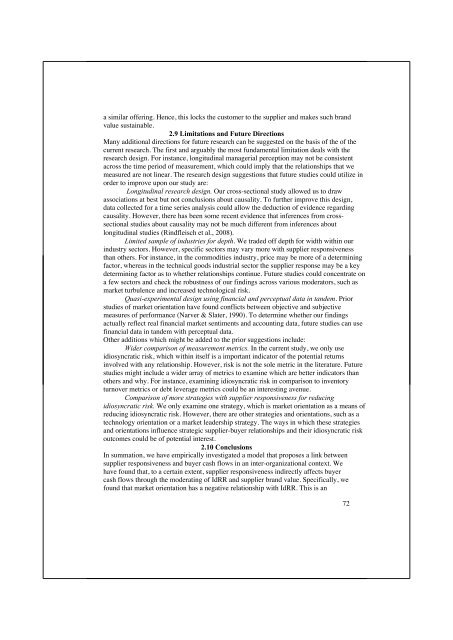Essays on supplier responsiveness and buyer firm value - Nyenrode ...
Essays on supplier responsiveness and buyer firm value - Nyenrode ...
Essays on supplier responsiveness and buyer firm value - Nyenrode ...
You also want an ePaper? Increase the reach of your titles
YUMPU automatically turns print PDFs into web optimized ePapers that Google loves.
a similar offering. Hence, this locks the customer to the <strong>supplier</strong> <strong>and</strong> makes such br<strong>and</strong><br />
<strong>value</strong> sustainable.<br />
2.9 Limitati<strong>on</strong>s <strong>and</strong> Future Directi<strong>on</strong>s<br />
Many additi<strong>on</strong>al directi<strong>on</strong>s for future research can be suggested <strong>on</strong> the basis of the of the<br />
current research. The first <strong>and</strong> arguably the most fundamental limitati<strong>on</strong> deals with the<br />
research design. For instance, l<strong>on</strong>gitudinal managerial percepti<strong>on</strong> may not be c<strong>on</strong>sistent<br />
across the time period of measurement, which could imply that the relati<strong>on</strong>ships that we<br />
measured are not linear. The research design suggesti<strong>on</strong>s that future studies could utilize in<br />
order to improve up<strong>on</strong> our study are:<br />
L<strong>on</strong>gitudinal research design. Our cross-secti<strong>on</strong>al study allowed us to draw<br />
associati<strong>on</strong>s at best but not c<strong>on</strong>clusi<strong>on</strong>s about causality. To further improve this design,<br />
data collected for a time series analysis could allow the deducti<strong>on</strong> of evidence regarding<br />
causality. However, there has been some recent evidence that inferences from crosssecti<strong>on</strong>al<br />
studies about causality may not be much different from inferences about<br />
l<strong>on</strong>gitudinal studies (Rindfleisch et al., 2008).<br />
Limited sample of industries for depth. We traded off depth for width within our<br />
industry sectors. However, specific sectors may vary more with <strong>supplier</strong> resp<strong>on</strong>siveness<br />
than others. For instance, in the commodities industry, price may be more of a determining<br />
factor, whereas in the technical goods industrial sector the <strong>supplier</strong> resp<strong>on</strong>se may be a key<br />
determining factor as to whether relati<strong>on</strong>ships c<strong>on</strong>tinue. Future studies could c<strong>on</strong>centrate <strong>on</strong><br />
a few sectors <strong>and</strong> check the robustness of our findings across various moderators, such as<br />
market turbulence <strong>and</strong> increased technological risk.<br />
Quasi-experimental design using financial <strong>and</strong> perceptual data in t<strong>and</strong>em. Prior<br />
studies of market orientati<strong>on</strong> have found c<strong>on</strong>flicts between objective <strong>and</strong> subjective<br />
measures of performance (Narver & Slater, 1990). To determine whether our findings<br />
actually reflect real financial market sentiments <strong>and</strong> accounting data, future studies can use<br />
financial data in t<strong>and</strong>em with perceptual data.<br />
Other additi<strong>on</strong>s which might be added to the prior suggesti<strong>on</strong>s include:<br />
Wider comparis<strong>on</strong> of measurement metrics. In the current study, we <strong>on</strong>ly use<br />
idiosyncratic risk, which within itself is a important indicator of the potential returns<br />
involved with any relati<strong>on</strong>ship. However, risk is not the sole metric in the literature. Future<br />
studies might include a wider array of metrics to examine which are better indicators than<br />
others <strong>and</strong> why. For instance, examining idiosyncratic risk in comparis<strong>on</strong> to inventory<br />
turnover metrics or debt leverage metrics could be an interesting avenue.<br />
Comparis<strong>on</strong> of more strategies with <strong>supplier</strong> resp<strong>on</strong>siveness for reducing<br />
idiosyncratic risk. We <strong>on</strong>ly examine <strong>on</strong>e strategy, which is market orientati<strong>on</strong> as a means of<br />
reducing idiosyncratic risk. However, there are other strategies <strong>and</strong> orientati<strong>on</strong>s, such as a<br />
technology orientati<strong>on</strong> or a market leadership strategy. The ways in which these strategies<br />
<strong>and</strong> orientati<strong>on</strong>s influence strategic <strong>supplier</strong>-<strong>buyer</strong> relati<strong>on</strong>ships <strong>and</strong> their idiosyncratic risk<br />
outcomes could be of potential interest.<br />
2.10 C<strong>on</strong>clusi<strong>on</strong>s<br />
In summati<strong>on</strong>, we have empirically investigated a model that proposes a link between<br />
<strong>supplier</strong> resp<strong>on</strong>siveness <strong>and</strong> <strong>buyer</strong> cash flows in an inter-organizati<strong>on</strong>al c<strong>on</strong>text. We<br />
have found that, to a certain extent, <strong>supplier</strong> resp<strong>on</strong>siveness indirectly affects <strong>buyer</strong><br />
cash flows through the moderating of IdRR <strong>and</strong> <strong>supplier</strong> br<strong>and</strong> <strong>value</strong>. Specifically, we<br />
found that market orientati<strong>on</strong> has a negative relati<strong>on</strong>ship with IdRR. This is an<br />
72
















